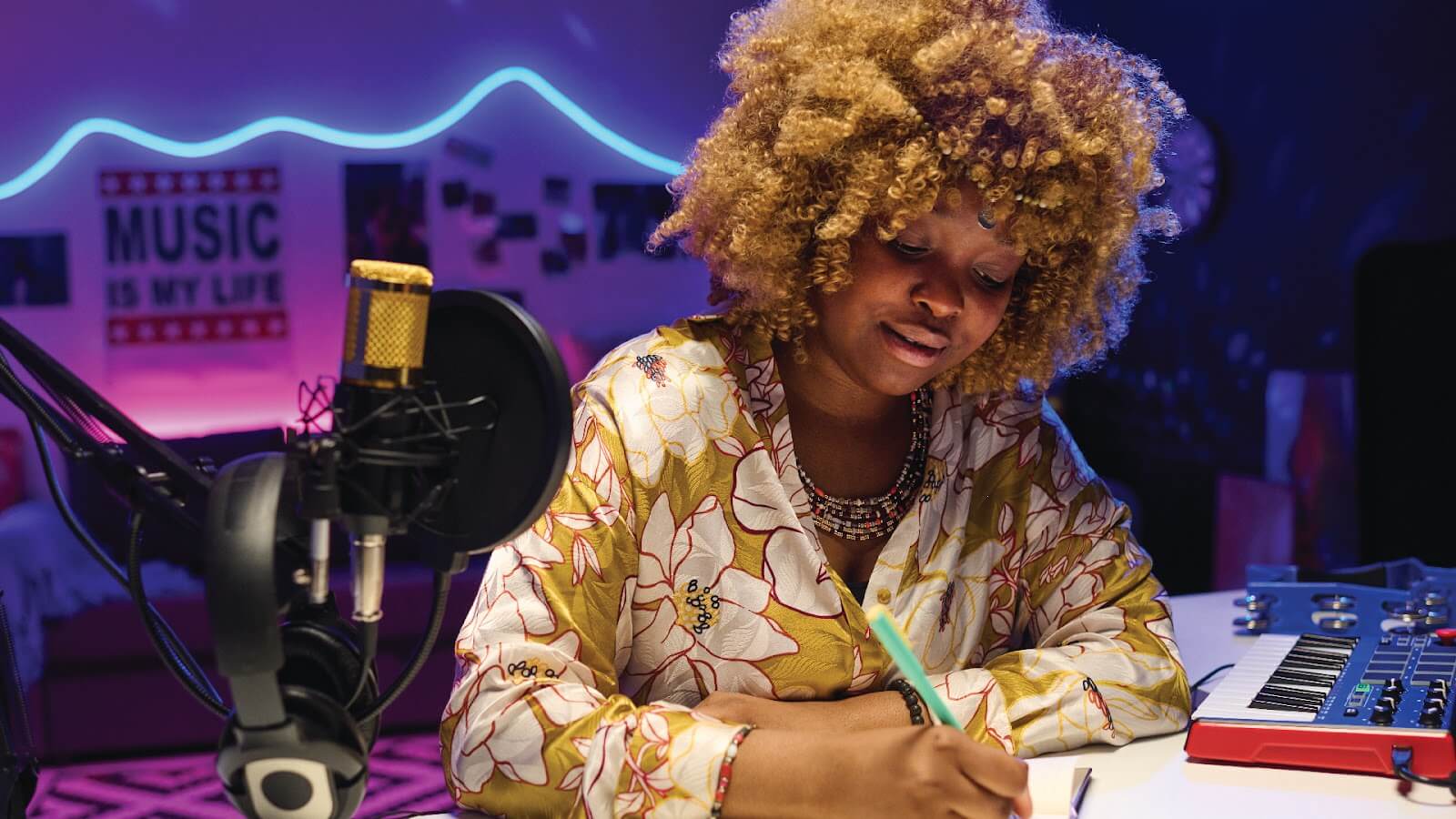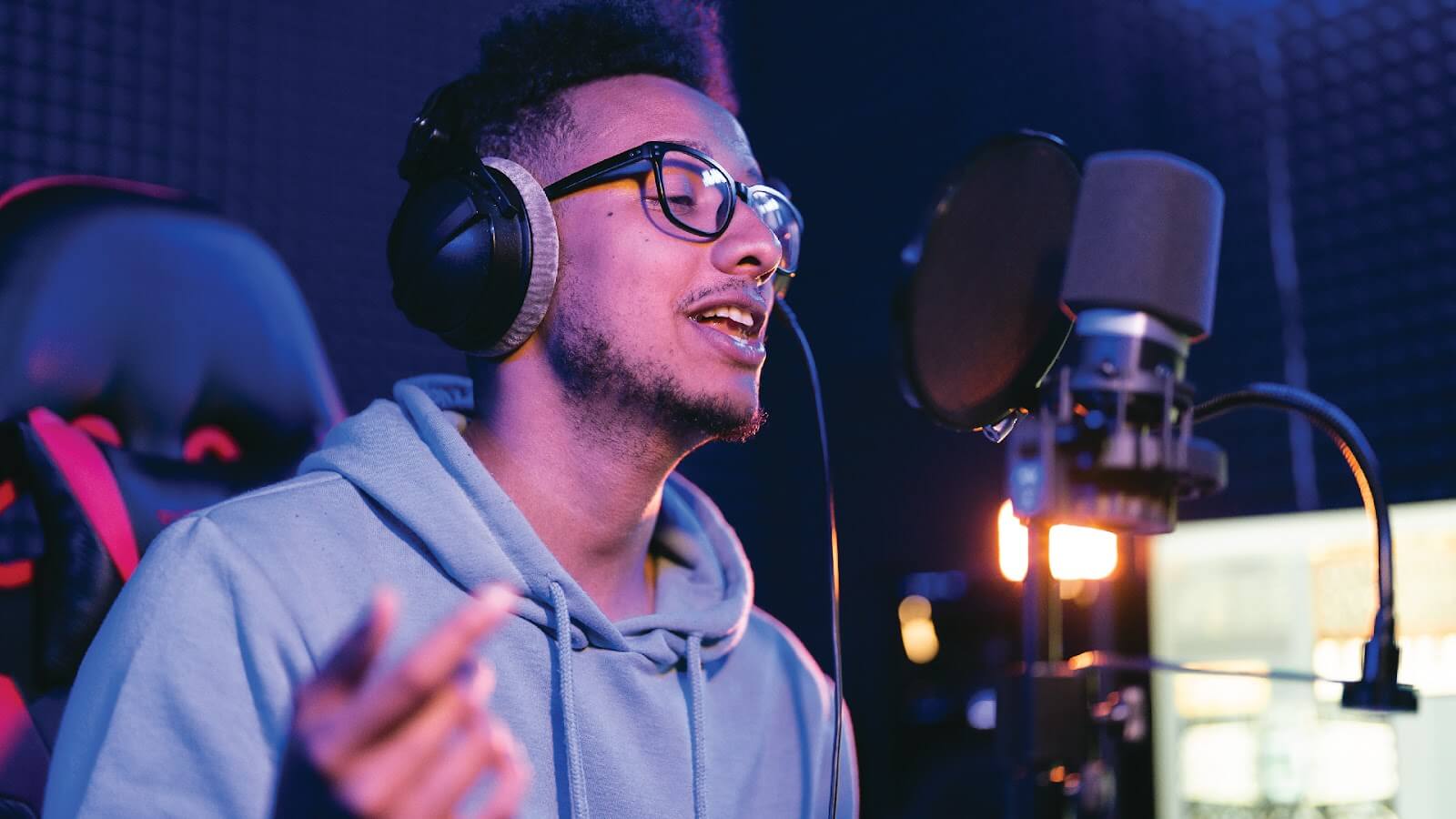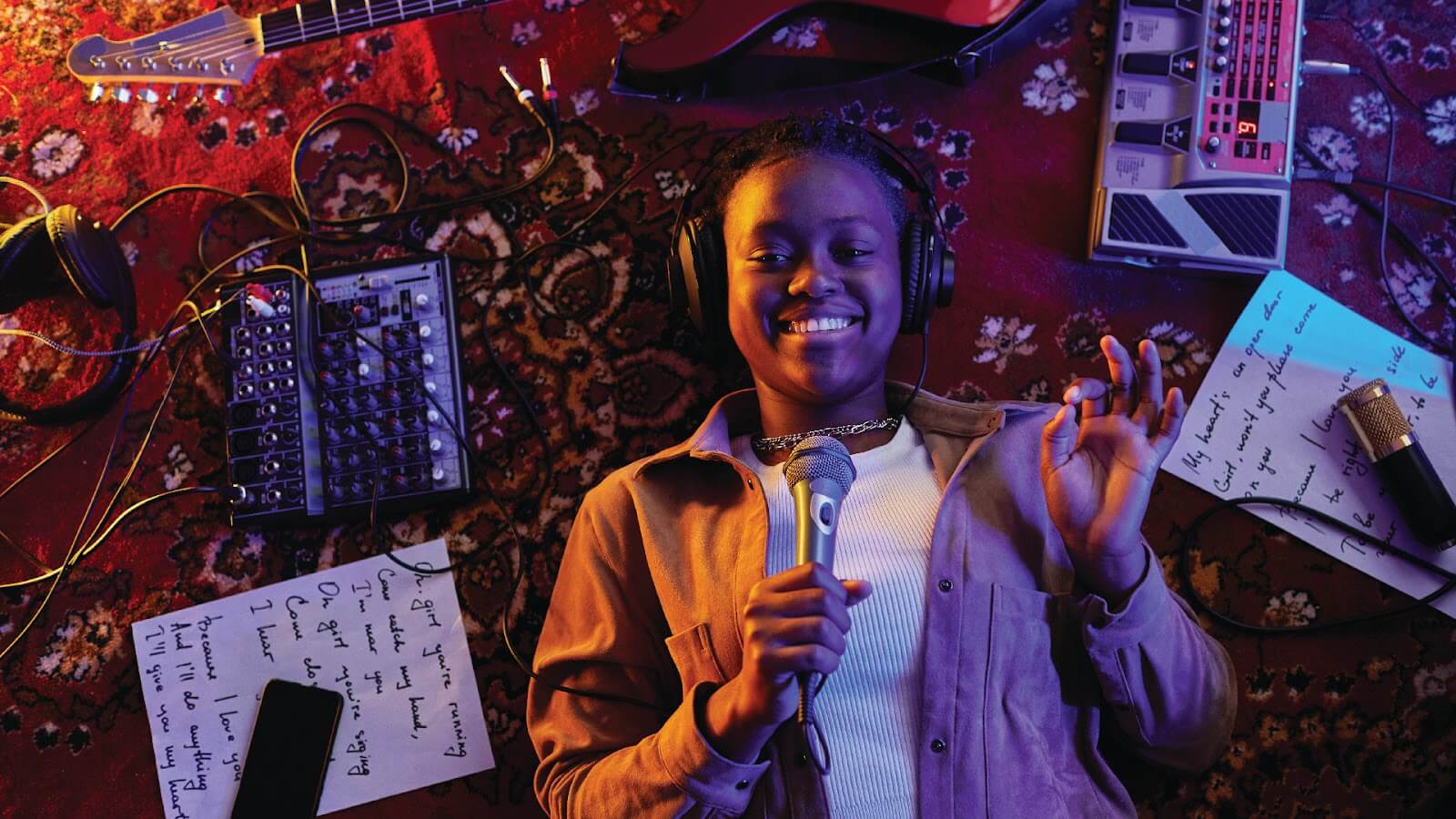Table of Contents
A solid rap lyric can hit you hard, balancing raw emotion with rhythm, while digging deep into the thoughts of the person who wrote it. Just like poetry, the best verses make you feel something, even if it’s just for a moment.
If you’re here, you may be looking to learn more about this art form and wondering how to write rap music lyrics that grab attention, tell a story, and resonate with listeners. You might have ideas bubbling up, thoughts about life, love, or struggle, and you’re trying to turn those into words that feel real and creative.
Writing rap lyrics starts with knowing your voice, what you want to say, and then layering that with the right words, rhythms, and flow. Like anything else in life, it’s a process that takes practice, but with time and the right guidance, you’ll be on your way to writing bars that reflect you and connect with your audience in no time.
Here’s a step-by-step guide on how to compose rap lyrics, whether you’re already a pro rapper or just looking to get started.
Glossary
Before we get into the nitty-gritty, there are a few important terms you need to know before you start writing:
- 808s: Deep, bass-heavy drum sounds, originally from the Roland TR-808 drum machine commonly used in hip-hop and trap music.
- Bars: Lines or verses in a rap song. A standard bar consists of one line, typically fitting into a four-beat measure.
- Beat: The instrumental track that sets the tempo and mood for the lyrics.
- Cadence: The pattern and intonation of speech in rap lyrics, affecting how verses are delivered and felt.
- Delivery: The way a rapper expresses their lyrics, including tone, volume, and emotion.
- Double-time: A rapping style where the delivery is twice as fast as the song’s regular beat.
- Flow: The rhythm and cadence of a rapper’s delivery.
- Freestyle: Rapping without pre-written lyrics, often improvised on the spot.
- Hook: The catchy, repeated part of a song, usually the chorus.
- Mastering: The final step in music production, where the track is polished, balanced, and optimized for different listening platforms.
- Mixing: Adjusting and blending individual sounds within a track to create a cohesive sound.
- Punchline: A clever or impactful line, often with wordplay, intended to make an impression.
- Rhyme Scheme: The pattern of rhyming words in verses that contributes to the rhythm and flow of lyrics.
- Sample: A segment of sound taken from another recording, often used as a foundation or accent within a new track.
- Verse: A section of the song where the main story or ideas are expressed. The verse is typically longer and more detailed than the hook.
Want to focus on the music? Learn more about how to make rap songs from beginning to end.
How to Write Rap Lyrics Like the Greats
So, how do you write rap lyrics that listeners will remember? Any rap and hip-hop lover knows that a good rap track leaves a mark that goes well beyond a few catchy lines. The best raps have a memorable purpose, style, and rhythm. That’s why understanding what makes some verses memorable while others fall flat is so important to developing your voice. From structuring bars to crafting unique flows, every piece plays a role.
So, if you’re wondering how to write rap lines that resonate, it helps to break down what the best rappers do and how they do it so well. Here’s how to get started:
1. Understand the Structure
A solid structure is the backbone of memorable rap lyrics. At the core of this structure are bars, which represent a single line, usually fitting within a four-beat measure. Structuring your song around bars gives it rhythm and order, allowing you to communicate complex ideas while keeping your listeners engaged. You can think of each bar as a line in a poem, and use it to create tension, release, or highlight key parts of your message.
Then there are rhyme schemes, which set the tone and help words stick. Different schemes like AABB (two pairs of rhyming lines) or ABAB (alternating rhymes) can completely change your song’s vibe. A great example is Eminem’s “Lose Yourself” — the internal rhymes within each line, as well as the track’s AABB scheme, make the song both intense and unforgettable.
2. Find Your Theme or Message
If you’re a fan of rap music, you know that the most powerful lyrics come from a place of real emotion or perspective. Personal stories make rap relatable, so consider incorporating experiences that define you or events that have shaped your life. To find your theme, think about what resonates with you personally. Whether it’s a personal struggle, a victory, or something else, your unique experience can give depth to your lyrics. For instance, Tupac’s "Keep Ya Head Up" speaks to themes of resilience and empowerment based on his own life and the experiences of those around him. Using real stories gives Tupac’s lyrics authenticity and makes them connect on a deeper level with his audience.
Rap is also a platform for social commentary. If you want to address social or political topics, look to artists like Kendrick Lamar in "How Much a Dollar Costs" or J. Cole in "Middle Child," who combine personal experiences with social and generational issues. Freestyling can be a great way to brainstorm themes; letting your ideas flow without overthinking can help you uncover topics that genuinely move you.
3. Start with a Hook
If you’ve been researching how to write rap song lyrics, you’ve probably come across the word “hook” on more than one occasion. The hook is what listeners remember long after the song ends, so it’s worth paying some attention to it. A powerful hook can be simple, like in Snoop Dogg’s "Drop It Like It’s Hot" — easy to remember, easy to repeat. So, when writing your hook, keep it connected to your theme and don’t be afraid to repeat a phrase or idea; repetition can actually make your hook feel more anchored and familiar.
Also, simplicity is key. Think about the theme of your song and try to boil it down to a few words or lines that hit home. Keep it direct and memorable, and don’t be afraid to experiment with different phrases or melodies until one feels right. A good hook should feel like the heartbeat of your track, effortlessly tying your lyrics together.
4. Write Your Verses
Verses are where you dig deeper and expand on your theme. Here’s where you can get creative with storytelling, add layers of meaning, or explore different perspectives. Use your verses to say what the hook can’t to add depth or tell another side of the story.
Here, you can incorporate punchlines and wordplay to keep listeners engaged. Clever twists of phrase, metaphors, and puns can make your verses stand out. A well-placed punchline can give your verse an unexpected twist, while wordplay allows for layers of meaning. Try practicing a few short verses on a beat to get comfortable, letting your lyrics flow naturally without overthinking every line. With practice, you’ll find your rhythm and build confidence in your delivery.
5. Focus on Rhyming Techniques
Rhyme is essential to any rap song, but mastering it involves more than using simple rhymes. Like in poetry, multi-syllable rhymes, or rhyming across multiple syllables, can help add complex layers to your lyrics and make them sound richer and more intricate. Songs that use complex rhyme structures, like Big L’s "Ebonics," are a great example of the depth multi-syllabic rhymes bring to a track. Complex rhymes add texture to the flow and elevate the overall feel of the lyrics.
Internal rhymes — where words rhyme within the line instead of just at the end — are also great for adding a hint of rhythm and style to your flow. If you’re stuck, use a rhyme dictionary or online tools to look up more unique rhymes. Even good old-fashioned dictionaries are great resources to help you find the perfect fit for a line or verse.
6. Experiment with Flow and Delivery
So, how do you rap lyrics after you’ve written them? It all comes down to flow and delivery. Your flow and delivery bring lyrics to life since matching your flow to the beat keeps your lyrics feeling in sync with the music. Experimenting with flow also allows you to adjust your rhythm, try out different tempos, and emphasize certain words to create unique effects.
Cadence, on the other hand, can make or break a verse, so adjusting it — speeding up, slowing down, or adding pauses — can add interest to your delivery. Try recording yourself using different speeds and tones to see what feels most natural. Practicing delivery helps you connect with the words and ultimately makes your rap more impactful.
7. Revise and Refine
Sometimes, the answer to writing a killer song is taking a step back and revisiting your lyrics with fresh eyes. Editing is incredibly important to make sure each line packs a punch and stays true to your message. So, after you’ve got a few ideas down, take a break and then come back to your lyrics to cut unnecessary words, sharpen your phrasing, and keep the focus clear.
Testing your lyrics on different beats is also a great way to make sure your words are versatile and that the flow remains smooth. This helps to identify any spots that might feel awkward or forced, the energy stays up, and your lyrics stand out.
8. Practice Freestyling and Improvisation
Freestyling is like working out for your rap skills — it keeps your creativity sharp and builds confidence. Set aside regular freestyle or improvising sessions to help ideas flow and strengthen your ability to think on your feet. It can be as simple as rapping about objects around you or jumping on random topics to push yourself to be spontaneous and resourceful with your words.
Another good idea is to challenge yourself with creative exercises, like describing everyday things in your freestyles or using prompts like emotions, names of people, or colors. These exercises make your mind more agile and open to new ideas, sometimes even sparking lyrics that you can later build into full songs. The more you practice, the more natural and flexible your rapping will feel, which will help you develop a style that’s uniquely yours.
Tips for Writing Rap Lyrics
Writing a rap song is as much about creativity as it is about technique. Even the best lyricists constantly learn, practice, and evolve. Whether you’re wondering how to make rap lyrics stand out or just looking to refine your flow, there are plenty of ways to develop your skills.
Here are some tips and resources to dive deeper into advanced rap writing techniques:
- Listen to the Greats: Study iconic lyricists like Nas, Rakim, Tupac Shakur, and Kendrick Lamar. Pay attention to how they structure their bars, build metaphors, and layer rhyme schemes. Listening to music with a critical ear can inspire new techniques and approaches.
- Get Feedback from Others: Share your lyrics with trusted friends, other rappers, or even online rap communities or forums. Getting constructive feedback can help reveal areas you might need to improve and highlight what you stand out at.
- Practice Freestyling: Freestyling isn’t only about spontaneity — it’s a powerful tool for finding your voice and pushing creativity. Set aside time to freestyle, experimenting with different rhythms and topics so you can start thinking quickly on your feet and get ideas for new verses.
- Write Consistently: Even if it’s just a line or two each day, keep writing. Building a habit will help you develop your skills and let ideas flow more naturally over time.
- Record Yourself: Listening to your recordings can help you identify areas for improvement in flow, delivery, and cadence. You can also experiment with different styles and see how each sounds in playback.
- Use Rhyme Dictionaries: Tools like RhymeZone or even a traditional rhyme dictionary can be invaluable for finding complex, multi-syllabic rhymes. This can make your tracks more interesting and your vocabulary richer.
- Listen to Songwriting Podcasts: Shows like And The Writer Is... explore the creative process of successful songwriters across genres. Though they cover more than just rap, the techniques and stories can apply directly to lyric writing.
- Stay Open to Inspiration: Inspiration can strike anywhere at any time, so be ready to capture it! Carry a notebook or use a notes app to jot down ideas, phrases, or experiences as they come. These sentences or snippets can later spark full verses or lines.
Learn from the Experts at Cadomu Music Academy
At Cadomu Music Academy, our mission is to support musicians of all types on their creative journey, offering the knowledge and tools they need to bring authentic expression to life.
If you’re an aspiring artist interested in how to write lyrics for rap, we’re here to provide you with what you need to hone your skills through expert-led classes and innovative technology. Our Rap 101 course covers everything from foundational techniques to advanced writing skills. We can also help you build your beat and find your flow.
So, whether you’re looking to write hard-hitting bars or explore complex rhyme schemes, Cadomu Music Academy is here to guide you every step of the way. Learn more about our songwriting classes and start your journey today!




